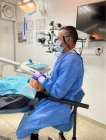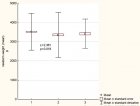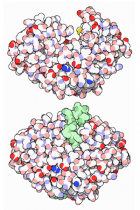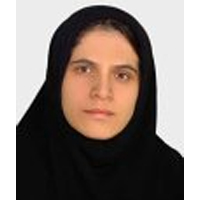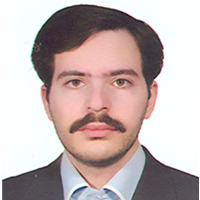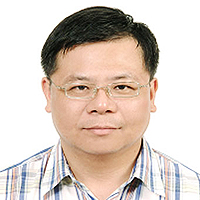Abstract
Research Article
Radiological assessment of exposure doses and radon exhalation rates of building materials in Saudi Arabia
Mohsen B Challan* and Atteyat A Labib*
Published: 23 February, 2018 | Volume 2 - Issue 1 | Pages: 012-021
In the present work, samples of building material are analyzed for their naturally occurring radioisotope activity such as uranium, radium, and radon. The radon emission rates, and the annual effective doses, "AED”, are also investigated. The activity of twenty-four samples, taken from the local markets of Saudi Arabia, was determined using the "Sealed-cup Technique” and Solid State Nuclear Track Detectors, "SSNTD.” The uranium concentration activity of the samples is found to vary from 0.62 to 4.68 ppm with an average of 1.92±0.42 ppm. The radium concentration varies from 0.61 to 4.64 Bq·kg−1, with an average of 1.91±0.42 Bq·kg−1, the radon concentration in the samples varies from 42.29 to 319.97 Bq·m−3 with an average of 131.53±28.94 Bq·m−3. The value of the dissolved radon concentration in the collected samples varies from 12.99 to 98.97 Bq·m−3 with an average of 40.41±8.89 Bq·m−3. The mass exhalation rates are found to vary from 1.54 to 11.65 mBq·kg−1·h−1, with an average of 4.79±1.05 mBq·kg−1·h−1, while the surface inhalation rates vary from 76.97 to 582.35 mBq·m−2·h−1, with an average of 239.38±52.66 mBq·m−2·h−1. The AED due to indoor uses varies from 1.07 to 8.07 mSv·y−1, with an average of 3.32±0.73 mSv·y−1. The AED due to indoor plus outdoor uses varies from 1.47 to 11.10 mSv·y−1, with an average of 4.56±1.0 mSv·y−1. The results of this study show that the values obtained for most samples are within the internationally accepted recommended values. Therefore, these samples can be used as building materials as they do not pose a major risk to humans.
Read Full Article HTML DOI: 10.29328/journal.jro.1001017 Cite this Article Read Full Article PDF
Keywords:
Radium; Radon exhalation rates; Exposure dose; Effective doses; SSNTD CR-39
References
- Rastogi N, Singh I. Levels of natural radioactivity in environment in residential area of Moradabad District, Western Uttar Pradesh. Pollution. 2017; 3; 1-7. Ref.: https://goo.gl/RWjHKT
- Khan AR, Rafique M, Rahman SU, Kearfott KJ, Matiullah. A review of radon measurement studies with nuclear track detectors (NTDs) in Azad Kashmir. Indoor and Built Environment. 2017; 26: 447-455. Ref.: https://goo.gl/FQjhYT
- Bavarnegin E, Vahabi-moghaddam M, Babakhani A, Fathabadi N. Analytical study of radionuclide concentration and radon exhalation rate in market available building materials of Ramsar. Journal of Theoretical and Applied Physics. 2012; 6: 5. Ref.: https://goo.gl/wWLgwe
- Hosoda M, Tokonami S, Omori Y, Ishikawa T, Iwaoka K. A comparison of the dose from natural radionuclides and artificial radionuclides after the Fukushima nuclear accident. J Radiat Res. 2016; 57: 422-430. Ref.: https://goo.gl/4f2y3M
- Bossew P. The radon emanation power of building materials, soils, and rocks. Applied Radiation and Isotopes. 2003; 59: 389-392. Ref.: https://goo.gl/3MwsHx
- Shahbazi-Gahrouei D. Natural background radiation Dosimetry in the highest altitude region of Iran. J Radiat Res. 2003; 44: 285-287. Ref.: https://goo.gl/q7qx6k
- Deb A, Gazi M, Barman C. Anomalous soil radon fluctuations-a signal of earthquakes in Nepal and eastern India regions. Journal of Earth System Science. 2016; 125: 1657-1665. Ref.: https://goo.gl/KnjNck
- Damla N, Kara A, Tel E, Yesilkanat CM. Mapping of indoor radon survey and dose estimations in health centers in Turkey. Indoor and Built Environment. 2017; 26: 327-336. Ref.: https://goo.gl/Cz6LNS
- Hafez AF, Hussein AS, Rasheed NM. A study of radon and thoron release from Egyptian building materials using polymeric nuclear track detectors. Applied Radiation and Isotopes. 2001; 54: 291-298. Ref.: https://goo.gl/ADYqgA
- Somogyi G, Hafez AF, Hunyadi I, Tóth-Szilágyi M. Measurement of exhalation and diffusion parameters of radon in solids by plastic track detectors. International Journal of Radiation Applications and Instrumentation. Part D. Nuclear Tracks and Radiation Measurements. 1986; 12: 701-704. Ref.: https://goo.gl/2q9C4b
- Abo-Elmagd M, Daif MM. Calibration of CR-39 for radon-related parameters using sealed cup technique. Radiat Prot Dosimetry. 2010; 139: 546-550. Ref.: https://goo.gl/9AjtdA
- Kropat G, Baechler S, Bailat C, Barazza F, Bochud F, et al. Calibration of the Polytrack system based on CR39 solid-state nuclear track detectors for passive indoor radon concentration measurements. Radiat Prot Dosimetry. 2015; 167: 302-305. Ref.: https://goo.gl/uUZvLb
- Misdaq MA, Elouardi B, Ouguidi J. Rn-222, Rn-220 and their progenies measured in the air of different dwellings and workplaces and resulting alpha radiation doses to the eyes of individuals. Health Physics. 2017; 113: 363-374.
- Sroor A, El-Bahi SM, Ahmed F, Abdel-Haleem AS. Natural radioactivity and radon exhalation rate of soil in southern Egypt. Appl Radi Is. 2001; 55: 873-879. Ref.: https://goo.gl/2SHiLM
Kumar A, Chauhan RP, Joshi M, Sahoo BK. Modeling of indoor radon concentration from radon exhalation rates of building materials and validation through measurements. J Environ Radioact. 2014; 50-55. Ref.: https://goo.gl/EnVZTP - Baykara O, Karatepe Ş, Doğru M. Assessments of natural radioactivity and radiological hazards in construction materials used in Elazig, Turkey. Radiation Measurements. 2011; 46: 153-158. Ref.: https://goo.gl/ictdKg
- Moharram BM, Suliman MN, Zahran NF, Shennawy SE, El Sayed AR. 238U, 232Th content and radon exhalation rate in some Egyptian building materials. Annals of Nuclear Energy. 2012; 138-143. Ref.: https://goo.gl/HWpRVp
- Effects of Ionizing Radiation. United, Nations, Scientific, Committee, on the Effects, of Atomic Radiation. 2000; 453-487.
Oikawa S, Kanno N, Sanada T, Abukawa J, Higuchi H. A survey of indoor workplace radon concentration in Japan. J Environ Radioact. 2006; 87: 239-245. Ref.: https://goo.gl/c3Mkyk - Singh H, Singh J, Singh S, Bajwa BS. Radon exhalation rate and uranium estimation study of some soil and rock samples from Tusham ring complex, India using SSNTD technique. Radiation Measurements. 2008; 459-462. Ref.: Ref.: https://goo.gl/jWW1FHb
- Mahmood A, Tufail M. Measurement of radon concentration for assessment of the radiological hazard in the Chakwal coalmines of the Salt Range, Pakistan. Journal of Radiological Protection. 2011; 31: 353-367. Ref.: https://goo.gl/JdQeZ1
- Yousef HA, Saleh GM, El-Farrash AH, Hamza A. Radon exhalation rate for phosphate rocks samples using alpha track detectors. Journal of Radiation Research and Applied Sciences. 2016; 9: 41-46. Ref.: https://goo.gl/eBm2Sm
- Baykara O, Doğru M, İnceöz M, Aksoy E. Measurements of radon emanation from soil samples in triple-junction of North and East Anatolian active faults systems in Turkey. Radiation Measurements. 2005; 39: 209-212. Ref.: https://goo.gl/9UEmnB
- Baykara O, Dogˇru M. Measurements of radon and uranium concentration in water and soil samples from East Anatolian Active Fault Systems (Turkey). Radiation Measurements. 2006; 41: 362-367. Ref.: https://goo.gl/qp1URb
- Nasir T, Shah M. Measurement of annual effective doses of radon from drinking water and dwellings by CR-39 track detectors in Kulachi City of Pakistan. Journal of Basic & Applied Sciences. 2012; 8: 528-536. Ref.: https://goo.gl/p8J6cjc
- Exposure to radiation from the natural activity in building materials. Organisation for Economic Co-operation Development. Nuclear Energy Agency. 1979.
NCRP. Guidance for emergency response dosimetry. National Council on Radiation Protection Measurements. 2017. - Stewart FA, Akleyev AV, Hauer-Jensen M, Hendry JH, Kleiman NJ, et al. ICRP publication 118: ICRP statement on tissue reactions and early and late effects of radiation in normal tissues and organs--threshold doses for tissue reactions in a radiation protection context. Ann ICRP. 2012; 41: 1-322. Ref.: https://goo.gl/XL5rNS
Figures:

Figure 1

Figure 2

Figure 3

Figure 4

Figure 5
Similar Articles
-
Radiological assessment of exposure doses and radon exhalation rates of building materials in Saudi ArabiaMohsen B Challan*,Atteyat A Labib*. Radiological assessment of exposure doses and radon exhalation rates of building materials in Saudi Arabia. . 2018 doi: 10.29328/journal.jro.1001017; 2: 012-021
Recently Viewed
-
Maternal and perinatal outcomes of uterine rupture in Lubumbashi, Democratic Republic of CongoJacques Ngoy Kitenge,Olivier Mukuku*,Xavier K Kinenkinda,Prosper L Kakudji. Maternal and perinatal outcomes of uterine rupture in Lubumbashi, Democratic Republic of Congo. Clin J Obstet Gynecol. 2020: doi: 10.29328/journal.cjog.1001067; 3: 136-141
-
Effect of sperm DNA fragmentation on ICSI outcome: A prospective studySaravanan Lakshamanan,Saravanan Mahalakshmi,Harish Ramya,Sharma Nidhi*. Effect of sperm DNA fragmentation on ICSI outcome: A prospective study. Clin J Obstet Gynecol. 2020: doi: 10.29328/journal.cjog.1001065; 3: 127-131
-
Forensic analysis of private browsing mechanisms: Tracing internet activitiesHasan Fayyad-Kazan*,Sondos Kassem-Moussa,Hussin J Hejase,Ale J Hejase. Forensic analysis of private browsing mechanisms: Tracing internet activities. J Forensic Sci Res. 2021: doi: 10.29328/journal.jfsr.1001022; 5: 012-019
-
A study of coagulation profile in patients with cancer in a tertiary care hospitalGaurav Khichariya,Manjula K*,Subhashish Das,Kalyani R. A study of coagulation profile in patients with cancer in a tertiary care hospital. J Hematol Clin Res. 2021: doi: 10.29328/journal.jhcr.1001015; 5: 001-003
-
Viral meningitis in pregnancy: A case reportRuth Roseingrave*,Savita Lalchandani . Viral meningitis in pregnancy: A case report. Clin J Obstet Gynecol. 2020: doi: 10.29328/journal.cjog.1001063; 3: 121-122
Most Viewed
-
Evaluation of Biostimulants Based on Recovered Protein Hydrolysates from Animal By-products as Plant Growth EnhancersH Pérez-Aguilar*, M Lacruz-Asaro, F Arán-Ais. Evaluation of Biostimulants Based on Recovered Protein Hydrolysates from Animal By-products as Plant Growth Enhancers. J Plant Sci Phytopathol. 2023 doi: 10.29328/journal.jpsp.1001104; 7: 042-047
-
Sinonasal Myxoma Extending into the Orbit in a 4-Year Old: A Case PresentationJulian A Purrinos*, Ramzi Younis. Sinonasal Myxoma Extending into the Orbit in a 4-Year Old: A Case Presentation. Arch Case Rep. 2024 doi: 10.29328/journal.acr.1001099; 8: 075-077
-
Feasibility study of magnetic sensing for detecting single-neuron action potentialsDenis Tonini,Kai Wu,Renata Saha,Jian-Ping Wang*. Feasibility study of magnetic sensing for detecting single-neuron action potentials. Ann Biomed Sci Eng. 2022 doi: 10.29328/journal.abse.1001018; 6: 019-029
-
Pediatric Dysgerminoma: Unveiling a Rare Ovarian TumorFaten Limaiem*, Khalil Saffar, Ahmed Halouani. Pediatric Dysgerminoma: Unveiling a Rare Ovarian Tumor. Arch Case Rep. 2024 doi: 10.29328/journal.acr.1001087; 8: 010-013
-
Physical activity can change the physiological and psychological circumstances during COVID-19 pandemic: A narrative reviewKhashayar Maroufi*. Physical activity can change the physiological and psychological circumstances during COVID-19 pandemic: A narrative review. J Sports Med Ther. 2021 doi: 10.29328/journal.jsmt.1001051; 6: 001-007

HSPI: We're glad you're here. Please click "create a new Query" if you are a new visitor to our website and need further information from us.
If you are already a member of our network and need to keep track of any developments regarding a question you have already submitted, click "take me to my Query."







